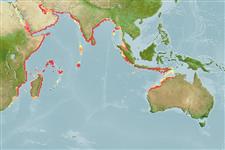Teleostei (teleosts) >
Siluriformes (Catfishes) >
Ariidae (Sea catfishes) > Ariinae
Eponymy: Edgar Leopold Layard (1824–1900) was born in Florence, Italy. [...] (Ref. 128868), visit book page.
More on author: Günther.
Issue
Junior synonym Arius tenuispinis Day, 1877 is valid according to ECoF (ver. 04 Sep 2024).
Environment: milieu / climate zone / depth range / distribution range
Ecology
Marine; brackish; demersal; amphidromous (Ref. 51243); depth range 20 - 50 m (Ref. 28016). Tropical
Western Indian Ocean: Mozambique and Persian Gulf to Sri Lanka.
Length at first maturity / Size / Weight / Age
Maturity: Lm 39.3 range ? - ? cm
Max length : 49.2 cm TL male/unsexed; (Ref. 121653); 51.0 cm TL (female); common length : 23.0 cm TL male/unsexed; (Ref. 3290); max. published weight: 1.3 kg (Ref. 121653); max. published weight: 1.3 kg
Found in coastal waters down to a depth of about 50 m (Ref. 5213). Enters brackish waters (Ref. 4833). Feeds mainly on invertebrates and small fishes. Caught mainly with bagnets, dipnets, bamboo stake traps and on hook and line.
Jayaram, K.C., 1984. Ariidae. In W. Fischer and G. Bianchi (eds.) FAO species identification sheets for fishery purposes. Western Indian Ocean fishing area 51. Vol. 1. FAO, Rome. pag. var. (Ref. 3290)
IUCN Red List Status (Ref. 130435: Version 2024-1)
Threat to humans
Traumatogenic (Ref. 58010)
Human uses
Fisheries: minor commercial
Tools
Special reports
Download XML
Internet sources
Estimates based on models
Preferred temperature (Ref.
123201): 25 - 29, mean 27.6 °C (based on 109 cells).
Phylogenetic diversity index (Ref.
82804): PD
50 = 0.5039 [Uniqueness, from 0.5 = low to 2.0 = high].
Bayesian length-weight: a=0.00708 (0.00594 - 0.00843), b=3.05 (3.00 - 3.10), in cm total length, based on LWR estimates for this species (Ref.
93245).
Trophic level (Ref.
69278): 4.0 ±0.61 se; based on food items.
Resilience (Ref.
120179): Medium, minimum population doubling time 1.4 - 4.4 years (K=0.2; Fec=538).
Fishing Vulnerability (Ref.
59153): Low to moderate vulnerability (32 of 100).
